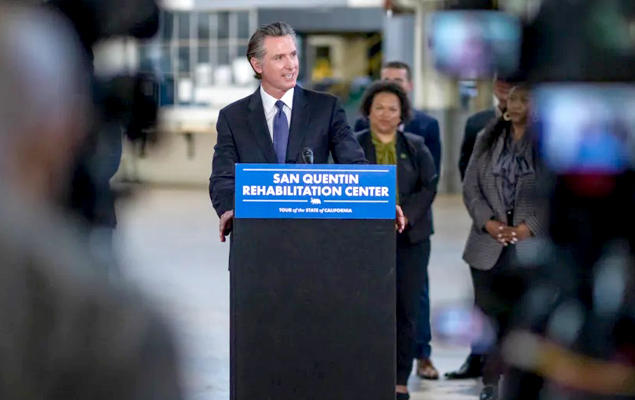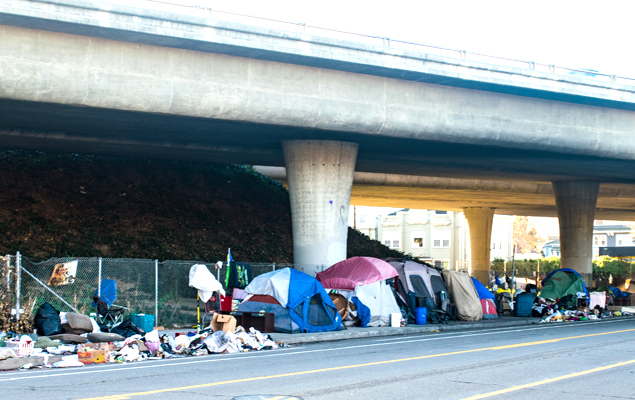
Governor Gavin Newsom, along with two key speakers, gave a detailed and impassioned recap of the first two weeks of his State of the State Tour in a briefing to over 60 media outlets on Wednesday in Sacramento. He reviewed the ambitious steps being taken to squelch homelessness, restructure an unproductive prison system, reduce the amount Californians spend on insulin, institute mental health reforms, among other issues facing the Golden State.
“Last week we had the opportunity to initiate the conversation highlighting the key initiatives, issues and progress we’ve made thus far and discuss the areas where we need to continue to do more and do better,” said the Governor. He then proceeded to break it down.
First, homelessness. Newsom acknowledged the statewide anger and lack of public trust of elected officials on the crisis and said two important areas need addressing. First, accountability. Four years ago, the state was allocating a half a billion dollars to support cities and counties to address the issue. But there were no plans nor accountability. Over the next couple of years, the budget is 15.3 billion with accountability front and center. Last year cities and counties whose plans were not ambitious enough were rejected. “No plans, no money,” said Newsom.
Those cities were then given discretionary grants but with strings attached to do better and to their credit, many brushed off their old plans and presented new and improved ones that measured up. They will receive bonuses if they meet their metrics and goals by the end of this month, said the Governor. The goal is to cut homelessness fifty per cent by 2025.
Second on the agenda was homeless encampments, which Newsom said must become a top priority in the state. Three years ago, there was no direct investment into addressing the issue. Now 750 million dollars has been set aside for encampment resolution/clean-up grants. “It’s not just out of sight, out of mind,” said the Governor.
“Housing and homelessness are closely connected and the problems are nationwide,” said the Secretary of Business, Consumer Services and Housing, Lourdes Castro Ramirez, one of the key speakers. “Only 30 in 100 housing units are affordable in California, disproportionately affecting people on fixed income, low wage workers, low-income families, and people of color.” Thus, people live in overcrowded dwellings, temporary shelters, cars and tents.
“It is about addressing the underlying issues and we highlighted the importance of having more alternative sights,” said Newsom. Therefore, the state is procuring 1,200 small homes which can sleep up to two, four or six people. The process is underway and should be in place by the end of fall. San Diego, Los Angeles and Sacramento are prime movers on this. Newsom said it’s not the solution but a solution to address the urgency of the problem. The plan is to eventually roll out the program statewide.

Next, the Governor laid out the state’s initiative to reimagine San Quentin prison. In the 70’s there were less than 3,000 in the prison system. That number peaked to 173,000 in the Schwarzenegger years and is today below 100,000. Newsom announced the closure of 4 prisons and was proud to announce the most transformative rehabilitation announcement in history that he hopes will be a model for the nation and the world. San Quentin will be reimagined through innovative data driven reform to make it the world’s most dynamic re-entry and rehabilitation facility. The Governor said it will be renamed in 2025 with a rehabilitative mindset, building off the 80 programs they already have in place, starting with an 81,000 square foot warehouse facility and repurposing death row into an honor yard.
“We are not converting or reducing sentences or letting prisoners out early as has been knowingly or unknowingly suggested,” said the Governor. “We believe this is a public safety-first initiative.” After their sentences, currently over 800 prisoners a year are released back into the community. But how? As fully integrated members of society? Newsom said over a three-year period, up to two thirds will either have modest parole violations and/or will likely commit another crime. “We have a public safety crisis and it must be addressed,” he said. “We’ve been quietly working on it for a few years and we are very excited to make this happen.”
CalRX was discussed next. The state will not just subsidize the cost of insulin but rather disrupt the entire market where patients will pay only 30 dollars, period. This is at cost. That’s not a copay, a discount card or subsidy passed on to the health plans or to premiums. “This is a game changer,” said Newsom. He announced they are partnering with a group in Virginia and will be opening a manufacturing facility where California will be making its own Naloxone.
“The cost of prescription drugs can cost people their livelihoods,” said Secretary of Health and Human Services, Mark Ghaly, another key speaker at the briefing. “What California is doing is not just another pharmaceutical company gimmick but something that will make a real difference in people’s lives with a positive effect on the ill in brown and black communities as they will finally feel supported.”
Part of the state tour included a visit to the border. The Governor announced 144 National Guard men and women are working to support our drug and interdiction efforts at the border and within the State of California. They are involved in 14 joint task forces in the San Diego area and along the state from Santa Barbara to San Jose. They will be expanding with 16 additional service men and women to do x-ray work of large vehicles coming through the border to address the meth and fentanyl crisis.
The Governor also announced their new fentanyl plan in which they will be investing federal opioid settlement dollars including a Naloxone distribution project. This will provide an additional 79 million dollars, which exceeds the 50 million in recent years, in an effort to create broader strategies for a larger public awareness campaign to thwart fentanyl usage to all middle schools, high schools and the general public at large. This will assist in treatment as well.
Next was the subject of people subsidizing or self-medicating with their drug and alcohol addiction. “We will reform the Mental Health Services Act that hasn’t been reformed in 20 years,” said the Governor. It will be updated to reflect the existing and persisting conditions as they relate to chronic disease management and substance abuse. People who are unhoused due to these conditions and are seeking help will now be eligible for housing under this act. “We have a coalition working on this with Darrell Steinberg who was the original author of the mental health initiative Prop 63 leading this effort along with Dr. Ghaly and others,” said Newsom.
Newsom has also asked for a multi-billion-dollar bond to make real his commitment to provide mental health related community-based placement alternatives – 6,000 throughout the state. This includes regional centers, step down facilities – not replicating the 50’s and 60’s when deinstitutionalization began but modern facilities that will address a myriad of needs. “This is the most exciting initiative I’ve ever been a part of,” said the Governor, “and I’m so grateful for our leaders today.”
And finally, the Governor spoke of CalAim, a seven-billion-dollar effort to reform the state’s Medi-Cal and Medicaid system. He said no other state is doing this kind of unprecedented support for universal healthcare. “We are poised, as we roll into 2025, to be the first state in U.S. history to have Universal Healthcare, regardless of preexisting conditions or immigration status and we are committed to do this regardless of budgetary constraints,” said the Governor, proudly.

